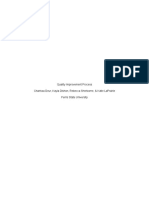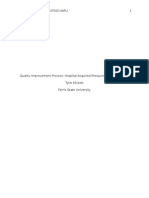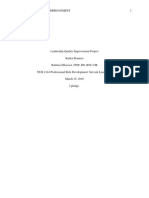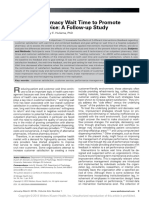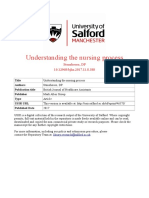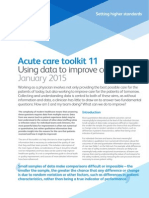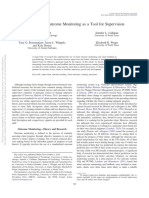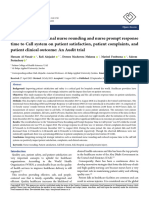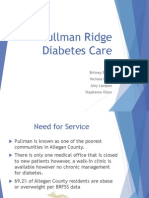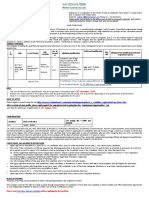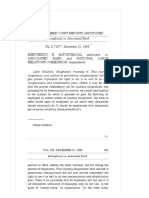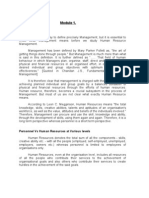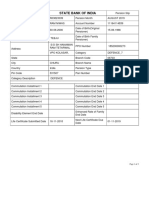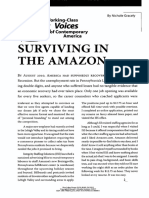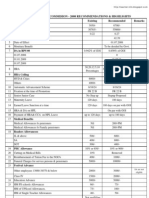Nurs 440 Leadershipstrategyanalysisgrouppaper
Nurs 440 Leadershipstrategyanalysisgrouppaper
Uploaded by
api-253019091Copyright:
Available Formats
Nurs 440 Leadershipstrategyanalysisgrouppaper
Nurs 440 Leadershipstrategyanalysisgrouppaper
Uploaded by
api-253019091Original Title
Copyright
Available Formats
Share this document
Did you find this document useful?
Is this content inappropriate?
Copyright:
Available Formats
Nurs 440 Leadershipstrategyanalysisgrouppaper
Nurs 440 Leadershipstrategyanalysisgrouppaper
Uploaded by
api-253019091Copyright:
Available Formats
Running head: LEADERSHIP STRATEGY ANALYSIS
Leadership Strategy Analysis
OSP Assignment Team Two
Ferris State University
LEADERSHIP STRATEGY ANALYSIS
2
Abstract
The nursing profession is committed to quality improvement. The purpose of this paper
is to analyze a clinical activity from a quality improvement perspective. Hourly rounds are
becoming a new standard of care that involves regular checks of individual patients. This
proactive intervention helps to decrease patient falls, improve patient satisfaction and promote a
less stressful work environment for staff. This paper discusses the clinical need for hourly
rounding, the interdisciplinary team involved in hourly rounding, the method chosen for data
collection, the goal for improvement, strategy implementation, evaluation and supportive
evidence of theory and current research.
LEADERSHIP STRATEGY ANALYSIS
Leadership Strategy Analysis
Introduction
Hourly rounding helps in the facilitation of the building of trust between a nurse and
patient, reduced incidence of falls, reduced call bell usage, reduced patient anxiety and increased
patient comfort, and improved pain management (Harrington et al., 2013, p. ). All of these
outcomes promote patient satisfaction and patient safety. The main goal of hourly rounding in
this paper is to decrease call light use.
Clinical Need
Increasing technological advances have been identified as a contributing factor in taking
the focus away from nursing care, resulting in increased patient falls and high use of patient call
lights (Harrington et al., 2013). To lessen this deterioration in standards of care in the acute
care environment where nursing turnover stands at 19%, suggestions have been made that
intentional rounding may be a method for facilitating increased nursing care, lessening turnover
and leading to greater patient and nurse satisfaction of care provision (Harrington et al., 2013, p.
524). Studies focusing on hourly rounding have shown an increase in both patient and nursing
satisfaction.
Hourly rounds help to keep up on basic patient needs that include feeding, pain
management, and repositioning (Harrington et al., 2013). In the study performed by Harrington
et al. (2013), it was found that decreased call lights occurred with hourly rounding. In a study
done by Meade et al. (2010), there was a 35% decrease in call light use after the implementation
of hourly rounding in an emergency room. Duffin (2010) reported that regular attention given to
patients resulted in a more controlled environment and actually reduced nurses' workload due to
the decrease need to respond to call lights.
LEADERSHIP STRATEGY ANALYSIS
Interdisciplinary Team Design
Quality necessitates maintaining safety in patient care, with a continual focus on clinical
excellence from the entire multidisciplinary team (Yoder-Wise, 2014, p. 390). The
interdisciplinary team for this quality initiative includes registered nurses, certified nurse
assistants (CNAs) and nurse managers. Registered nurses should be the main advocates for
hourly rounding. At each hourly round, staff should assess pain, toileting needs, thirst and
hunger and answer any questions the patient may have.
Nurses may perform basic needs or delegate them to CNAs. CNAs will collaborate with
nurses to ensure the rounds are completed and all needs are met. The nurse manager will be in
charge of monitoring hourly rounding documentation to ensure standards of care are met.
Additionally, the nurse manager can collect data and evaluate the outcome of hourly rounding.
Nursing management will report findings with hospital administration for collaboration. Each
person on this team is capable of helping with certain tasks in this process and they are all
necessary.
Data Collection
Data collection on hourly rounding can be done through patient satisfaction surveys. Due
to the fact that some patients may be confused or often have family at the bedside, surveys can
be completed by either the patient or their family member. Surveys should either be sent home
with the patient at discharge or mailed within seven days of discharge. The surveys should
remain private, unless the patient or family member wishes to be contacted for further questions
or comments.
Requested data for the survey would include identification as a patient or family member,
whether or not a staff member checked on the patient every hour, if needs were met when
LEADERSHIP STRATEGY ANALYSIS
appropriate, if a fall occurred or if a skin ulcer developed during the stay, if pain was adequately
controlled and whether or not fresh beverages were provided. If a staff member did not meet the
expectation of an hourly check, the patient or family will be given a chance to comment if staff
provided an explanation. These surveys would also leave room for any additional comments or
concerns. According to Bradley et al. (2013), Those patients who did complete and return the
surveys rated their care very highly over all aspects of care (being seen promptly, provision of
assistance for meals, drinks and comfort, pain relief, safety and respect) (p. 527). Overall data
can be collected and improvement can be made to ensure patient satisfaction.
The frequency of call lights will be monitored before and after implementing hourly
rounds. Additional data to be gathered will include incidence of patient falls and staff
satisfaction.
Outcomes Established
The overall objective of hourly rounding is to improve staff working environment and
increase patient satisfaction by meeting their needs efficiently. According to Halm (2009),
attending to patients comfort, safety, and environmental needs may also prevent adverse events
like falls, pressure ulcers, or unrelieved pain; and contribute to patients satisfaction and nursing
care (p. 581). By addressing patients needs more often, not only is the nursing staff keeping
surveillance on their patients, but proactively meeting their needs and safety. Hourly rounding
also promotes organized workflow and helps anticipate patient needs.
Strategy Implementation
In a perfect world, a hospital would always be adequately staffed, whether it is day shift,
nights or weekends, to ensure hourly rounding is completed effectively. Since this is not the
case, we must find other efficient ways to round on patients. Halm (2009) has suggested that
LEADERSHIP STRATEGY ANALYSIS
registered nurses make rounds on even hours and support staff make rounds on odd hours (p.
581). Because not all units have support staff to help with hourly rounds, another alternative
would is needed.
For units that do not have support staff, the registered nurse would need to make hourly
rounds. They could show that they are rounding by charting what the patient needed or if the
patient denied any needs. Documentation of needs during hourly rounds is also a good way to
show if the nursing staff is meeting their outcomes and patient satisfaction.
Halm (2009) has concluded, in 5 to 6 studies (83%) that examined use of call lights, the
use was reducedFall rates were also shown to reduce by 77% (2009, p. 581). Because
evidence supports hourly rounding, hospitals need to take this into consideration and educate
staff on its importance. When nurses have help on the floor, they are able to delegate a portion
of the rounds. Nurses also need to explain hourly rounding to both patients and families. By
providing education, it will help implement this strategy and hopefully become second nature to
everyone involved.
Evaluation
Our first step in the evaluation process will be to establish a baseline by collecting data in
the pre-implementation phase. We will measure the frequency of call light use, patient
satisfaction with specific areas of care, staff satisfaction, and number of falls that occur over a
period of six months prior to initiating hourly rounds. Call light usage will be measured through
the use of a log. Falls will be calculated from incident reports. Patient and staff satisfaction will
be calculated using the survey method. From there, an established leadership auditing process
will be created. According to Claude-Gutekunst, et al. (2012), things to establish include a fully
developed and clearly communicated protocol, annual competencies, new employee orientation,
LEADERSHIP STRATEGY ANALYSIS
and remediation support for the process (p.). Qualitative and quantitative metrics should be
established to measure success and recognition of staff should occur with successes (ClaudeGutekunst, 2012). The evaluation will consist of a statistical analysis of scores prior to
implementation in comparison to scores over a period of six months after implementation. Staff
buy-in and dedication to participation in implementing the change will be key factors in the
success of this initiative.
Change can be very difficult for people, some more than others. Change requires staff to
put time and effort into the practice modification that they may not desire to if they do not
believe in the necessity of the change. According to the Transtheoretical Model, behavior
change is a process that one undergoes over time through stages. The stages progress from precontemplation and unawareness of the need for change to maintenance of the change upon
implementation. As an individual becomes aware of an issue in the contemplation stage and
takes part in the action to fix the problem, the success hinges on their willingness to make the
change habit.
Scholarship
Through incessant implementation of updates in evidence-based practice the unit is able
to function offering the highest quality and safest care possible. The focus needs to be on
continual transition towards clinical excellence. Thorough research was completed on the topic
of hourly rounds and the impact it will have on the frequency of call light use, as well as the
impact on patient satisfaction with the timeliness of call light response. According to
Harrington, et al. (2013), if nurses made more regular and frequent rounds of patients allocated
to their care through intentional rounding, then patients should be more willing to wait for
assistance. This approach in turn would reduce the frequency of call bell use (p.525). It is
LEADERSHIP STRATEGY ANALYSIS
suggested that if nurses and other patient care staff completed consistent intentional rounds the
patients would likely decrease their overall call light use due to the security they feel in knowing
that the nurse will return in a timely manner automatically.
According to Krepper, et al. (2012), a number of studies measured call light usea 6
week nationwide study at 14 hospitals and 27 nursing units showed a significant reduction in call
light use demonstrated on the experimental units using 1-hour rounding (p.2). A decrease in
call light use supports the nurses during their time spent completing hourly rounds. The nurses
move from a reactive care strategy to a proactive care strategy anticipating the needs of their
patients.
Hourly rounds play a very important role in building relationships equally amongst the
patients. According to Harrington, et al. (2013), Intentional rounding thus ensured that all
patients received regular care instead of care unequally distributed among patients when focused
towards excessive call light use (p.524). One family member stated, We actually felt as if our
brother was the only patient on the floor. Everyone kept checking on him constantly (ClaudeGutekunst, 2012, p.). Building trust in the healthcare team, from the patient and their family,
results in a significant decrease in anxiety, an increase in patient compliance with care and an
overall satisfaction with the care provided. Providing patient-centered, relationship-based care is
vital to supporting the best possible outcomes for the patients as well as the best overall patient
satisfaction with care.
Conclusion
The change from the current reactive nursing practice to the more proactive form of
hourly rounding has received much applause in the studies. The impact that hourly rounds have
on the overall quality and safety of patient care, as well as patient and staff satisfaction, is
LEADERSHIP STRATEGY ANALYSIS
paramount. A decrease in call light use results in a decrease in time and motion from staff. A
decrease in call light use is a direct indicator that the patients needs are being met more
proactively, resulting in an increased trust in the medical team. The benefits of hourly rounding
go way beyond the focused goals of this paper.
LEADERSHIP STRATEGY ANALYSIS
10
References
Duffin, C. (2010). Hourly ward rounds improve care and reduce staff stress. Nursing
Management, 17(7), 6-7. Retrieved from
http://go.galegroup.com/ps/i.do?id=GALE%7CA241779981&v=2.1&u=lom_ferrissu&it
=r&p=ITOF&sw=w&asid=4e4018b8695f640a9dc0764b0b454563
Halm, M. (2009). Hourly rounds: what does the evidence indicate? American Journal of Critical
Care, 18(6), 581-584. http://dx.doi.org/10.4037/ajcc2009350
Harrington, A., Bradley, S., Jeffers, L., Linedale, E., Kelman, S., & Killington, G. (2013). The
implementation of intentional rounding using participatory action research. International
Journal of Nursing Practice, 19(5), 523-529. http://dx.doi.org/10.1111/ijn.12101
Kessler, B., Claude-Gutekunst, M., Donchez, A. M., Dries, R. F., & Snyder, M. M. (2012). The
merry-go-round of patient rounding: assure your patients get the brass ring. MEDSURG
Nursing, 21(4), 240-245.
Krepper, R., Vallejo, B., Smith, C., Lindy, C., Fullmer, C., Messimer, S., & Xing, Y. (2012).
Evaluation of a standardized hourly rounding process. , 1-8. http://dx.doi.org/Krepper, R.,
Vallejo, B., Smith, C., Lindy, C., Fullmer, C., Messimer, S., & Xing, Y. (2012).
Evaluation of a standardized hourly rounding process. Journal of Healthcare Quality, 00
(0), 1-8. doi: 10.1111/j.1945-1474.2012.00222.x
Meade, C. M., Kennedy, J., & Kaplan, J. (2010). The effects of emergency department staff
rounding on patient safety and satisfaction. Journal of Emergency Medicine, 38, 666-674.
Yoder-Wise, P. S. (2014). Leading and Managing in Nursing (5 ed.). St. Louis, MO: Saunders.
You might also like
- Quantitative Article Critique and SummaryDocument8 pagesQuantitative Article Critique and SummaryEmmanuelNo ratings yet
- Effectiveness of A Fall Prevention ChecklistDocument36 pagesEffectiveness of A Fall Prevention ChecklistAndreaNo ratings yet
- Aea-V 2009 EbaDocument110 pagesAea-V 2009 EbaDave JonesNo ratings yet
- Prelim HRDocument2 pagesPrelim HRNoemi NadadoNo ratings yet
- Quality Improvement ProcessDocument10 pagesQuality Improvement Processapi-284596154No ratings yet
- Journal Article Critique Nursing 665Document5 pagesJournal Article Critique Nursing 665api-214213767No ratings yet
- Quality Improvement ProcessDocument8 pagesQuality Improvement Processapi-283424486No ratings yet
- Quality Improvement ProjectDocument7 pagesQuality Improvement Projectapi-272534722100% (1)
- Improving Team Structure and Communication: EffectiveDocument31 pagesImproving Team Structure and Communication: EffectiveSutisna NisaNo ratings yet
- Leadership Strategy Analysis FinalDocument8 pagesLeadership Strategy Analysis Finalapi-242603823No ratings yet
- Leadership AnalysisDocument8 pagesLeadership Analysisapi-260554694No ratings yet
- Running Head: PATIENT FALLS 1Document9 pagesRunning Head: PATIENT FALLS 1api-284786443No ratings yet
- Quality and Safety Synthesis PaperDocument6 pagesQuality and Safety Synthesis Paperapi-252807964No ratings yet
- Nursing Round 2023Document20 pagesNursing Round 2023risetmikawaruNo ratings yet
- Wet 28393Document10 pagesWet 28393shumailanaz6677No ratings yet
- Effectiveness of Hourly RoundingDocument7 pagesEffectiveness of Hourly RoundingMaria Lpz100% (1)
- Open VsDocument16 pagesOpen Vsapi-482726932No ratings yet
- The Impact of Nurse Rounding On Patient Satisfaction in A Medical-Surgical Hospital UnitDocument7 pagesThe Impact of Nurse Rounding On Patient Satisfaction in A Medical-Surgical Hospital UnitBheru LalNo ratings yet
- Evidence Based Standards For Measuring Nurse Staffing and PerformanceDocument208 pagesEvidence Based Standards For Measuring Nurse Staffing and Performancemr_jamzNo ratings yet
- He U.S. Hospital System Suffers From ShortfallsDocument8 pagesHe U.S. Hospital System Suffers From Shortfallsjoy gorreNo ratings yet
- Quality Improvement ProjectDocument6 pagesQuality Improvement Projectapi-317112346No ratings yet
- Final Paper Nur410Document10 pagesFinal Paper Nur410api-598929897No ratings yet
- Final Safety Group Paper490WDocument17 pagesFinal Safety Group Paper490WLYZETTE TERMANNo ratings yet
- Evidence Based Standards For Measuring Nurse Staffing and PerformanceDocument208 pagesEvidence Based Standards For Measuring Nurse Staffing and PerformanceA As'ad MaoNo ratings yet
- Nur 4144 - Qi Project PaperDocument8 pagesNur 4144 - Qi Project Paperapi-391107694No ratings yet
- Assingnment 3 775Document17 pagesAssingnment 3 775madhwa79No ratings yet
- Successful Translation of Evidence To Improve Clinical PracticeDocument3 pagesSuccessful Translation of Evidence To Improve Clinical Practiceapi-488538030No ratings yet
- Burnout Among Healthcare Professionals in Ghana A Critical AssessmentDocument1 pageBurnout Among Healthcare Professionals in Ghana A Critical AssessmentETON VICTORIANo ratings yet
- Root Cause Analysis of A Safety ProblemDocument6 pagesRoot Cause Analysis of A Safety Problemapi-300602911No ratings yet
- Nursing Sensitive Indicators Their RoleDocument3 pagesNursing Sensitive Indicators Their RolePuspita Eka Kurnia SariNo ratings yet
- The Positive Impact of Continuous ImprovementDocument15 pagesThe Positive Impact of Continuous ImprovementMane DaralNo ratings yet
- Developing Organizational Policies and Practices ADocument7 pagesDeveloping Organizational Policies and Practices Amutisya johnboscoNo ratings yet
- Slowiak 2015Document12 pagesSlowiak 2015Dr RoshanNo ratings yet
- Jurnal Lean JCIDocument9 pagesJurnal Lean JCIkristina dewiNo ratings yet
- Understanding The Nursing ProcessDocument7 pagesUnderstanding The Nursing ProcessAbdul HakeemNo ratings yet
- Toolkit11 Data To Improve CareDocument6 pagesToolkit11 Data To Improve CareAbd ZouhierNo ratings yet
- Relationship Between Nursing Handoff Quality and Continuity of Care in Intensive Care UnitDocument12 pagesRelationship Between Nursing Handoff Quality and Continuity of Care in Intensive Care UnitImpact JournalsNo ratings yet
- Using Client Outcome Monitoring As A Tool For SupervisionDocument5 pagesUsing Client Outcome Monitoring As A Tool For SupervisionDianaSantiago100% (1)
- Informatics ProjectDocument7 pagesInformatics ProjectShannon TerrellNo ratings yet
- Qi Poster-Team HuddlesDocument1 pageQi Poster-Team Huddlesapi-258915393No ratings yet
- Improving Bedside Shift-To-shift Nursing Report ProcessDocument34 pagesImproving Bedside Shift-To-shift Nursing Report ProcessJaypee Fabros Edra100% (2)
- Quality Improvement Paper FinalDocument11 pagesQuality Improvement Paper Finalapi-291740538No ratings yet
- BUS6004 Quality Management in A Care Setting - EditedDocument13 pagesBUS6004 Quality Management in A Care Setting - EditedMashaal FNo ratings yet
- Quality Improvement Proposal PaperDocument7 pagesQuality Improvement Proposal Paperapi-533686691No ratings yet
- NMS - Volume 12 - Issue 3 - Pages 142-150Document9 pagesNMS - Volume 12 - Issue 3 - Pages 142-150Chelly May CiprianoNo ratings yet
- Leadership Analysis PaperDocument8 pagesLeadership Analysis Paperapi-238680155No ratings yet
- Patient Safety and Leadership: Do You Walk The Walk?: S A F E T YDocument5 pagesPatient Safety and Leadership: Do You Walk The Walk?: S A F E T YRosliana MahardhikaNo ratings yet
- Patients' Waiting Time: Indices For Measuring Hospital EffectivenessDocument18 pagesPatients' Waiting Time: Indices For Measuring Hospital Effectivenessmr kevinNo ratings yet
- Final ProjectDocument85 pagesFinal Projectshubham solankiNo ratings yet
- Relationshipbasedcarepaper - NSG 4040-1Document13 pagesRelationshipbasedcarepaper - NSG 4040-1api-314231356No ratings yet
- Nursing Sciences English Department, Second YearDocument11 pagesNursing Sciences English Department, Second Yearmosto mostoNo ratings yet
- Evidence Based RUADocument12 pagesEvidence Based RUAAsma AliNo ratings yet
- Self-Leadership in A Critical Care Outreach Service For Quality Patient CareDocument19 pagesSelf-Leadership in A Critical Care Outreach Service For Quality Patient CareKamila AmmarNo ratings yet
- Week 6 Nursing LeadershipDocument6 pagesWeek 6 Nursing LeadershipFranklin Mung'athia BettNo ratings yet
- Guelph General HospitalDocument7 pagesGuelph General Hospitalfrosty tarp100% (1)
- Irl FinalDocument17 pagesIrl Finalapi-663098440No ratings yet
- Michael Et Al-2013-Journal For Healthcare QualityDocument11 pagesMichael Et Al-2013-Journal For Healthcare QualityjessicaNo ratings yet
- Integrating Evidence-Based Practice: Monica Mwaniki Aspen UniversityDocument9 pagesIntegrating Evidence-Based Practice: Monica Mwaniki Aspen Universityberrick otienoNo ratings yet
- The Maximally Efficient and Optimally Effective Emergency Department: One Good Thing A DayFrom EverandThe Maximally Efficient and Optimally Effective Emergency Department: One Good Thing A DayNo ratings yet
- Health Care Delivery Manager- The Comprehensive Guide: Vanguard ProfessionalsFrom EverandHealth Care Delivery Manager- The Comprehensive Guide: Vanguard ProfessionalsNo ratings yet
- The COAT & Review Approach: How to recognise and manage unwell patientsFrom EverandThe COAT & Review Approach: How to recognise and manage unwell patientsRating: 5 out of 5 stars5/5 (1)
- Advocacy Position LetterDocument3 pagesAdvocacy Position Letterapi-253019091No ratings yet
- Back Care PowerpointDocument17 pagesBack Care Powerpointapi-253019091No ratings yet
- Running Head: Pico Question: Aseptic Technique 1Document10 pagesRunning Head: Pico Question: Aseptic Technique 1api-253019091No ratings yet
- Final PresentationDocument17 pagesFinal Presentationapi-253019091No ratings yet
- EHS Rules, Discipline & EHS Policy 2020Document6 pagesEHS Rules, Discipline & EHS Policy 2020suman sarmaNo ratings yet
- Assistant Operations ManagerDocument2 pagesAssistant Operations ManagerAbdirahman MusaNo ratings yet
- Answers 506Document59 pagesAnswers 506singh gurtej100% (2)
- Spicewood Stables Inc Was Established in Dripping Springs Texas OnDocument1 pageSpicewood Stables Inc Was Established in Dripping Springs Texas OnFreelance WorkerNo ratings yet
- Balmer Lawrie & Co HRDocument6 pagesBalmer Lawrie & Co HRPraneet TNo ratings yet
- 02 Batongbacal V Associated BankDocument14 pages02 Batongbacal V Associated BankyousirneighmNo ratings yet
- A Guide To Working Near The Electric Power NetworkDocument33 pagesA Guide To Working Near The Electric Power NetworkMilos VajagicNo ratings yet
- AnswersDocument43 pagesAnswerseshu eshangNo ratings yet
- Leadership & Management 2013 HandoutsDocument138 pagesLeadership & Management 2013 HandoutsHampson Malekano88% (8)
- Full HRM Notes by Ram Chad Ran SirDocument122 pagesFull HRM Notes by Ram Chad Ran SirKrupa PatilNo ratings yet
- Economic and Non Economic ActivitiesDocument4 pagesEconomic and Non Economic ActivitiesGunjan JainNo ratings yet
- Local Recruitment Information To Contractors April 2011 Version 1 CTDocument1 pageLocal Recruitment Information To Contractors April 2011 Version 1 CTMamoudou CISSENo ratings yet
- EPF Member Passbook Ramachanderan VDocument2 pagesEPF Member Passbook Ramachanderan VTAMILAN KINGNo ratings yet
- Princ Ch19 Presentation7eDocument33 pagesPrinc Ch19 Presentation7eAbhishek M S100% (1)
- C) An "Apprenticeable" Occupation" Means Any Trade, Form ofDocument6 pagesC) An "Apprenticeable" Occupation" Means Any Trade, Form ofMa Tiffany CabigonNo ratings yet
- The Nature of Staffing: Chapter One Staffing Models and StrategyDocument32 pagesThe Nature of Staffing: Chapter One Staffing Models and StrategyHasib AhsanNo ratings yet
- Paul Coward, Tullow Oil, On EISA in Ghana and UgandaDocument18 pagesPaul Coward, Tullow Oil, On EISA in Ghana and Ugandatsar_philip2010No ratings yet
- No Job Affidavite-converted-HSSCDocument2 pagesNo Job Affidavite-converted-HSSCpuniaabhishek88No ratings yet
- WEI YUAN Company PolicyDocument28 pagesWEI YUAN Company PolicyMark Anthony RojoNo ratings yet
- Case Study 3Document2 pagesCase Study 3Kulot BautistaNo ratings yet
- Pension Slip PDFDocument2 pagesPension Slip PDFRamniwas TetarwalNo ratings yet
- Report 2Document20 pagesReport 2Vishala GudageriNo ratings yet
- Surviving in The AmazonDocument5 pagesSurviving in The Amazonrockettim123No ratings yet
- Hana's InternshipDocument20 pagesHana's InternshipTEGEGN100% (1)
- Report HRMDocument54 pagesReport HRMsh10821No ratings yet
- Fixation Table PRC-08Document2 pagesFixation Table PRC-08navn7650% (2)
- Compensation and Benefits:: Apurv KumarDocument26 pagesCompensation and Benefits:: Apurv KumarVinya RahulNo ratings yet
- Essay-The Role of Money As A MotivatorDocument2 pagesEssay-The Role of Money As A MotivatorSofia MartaNo ratings yet




